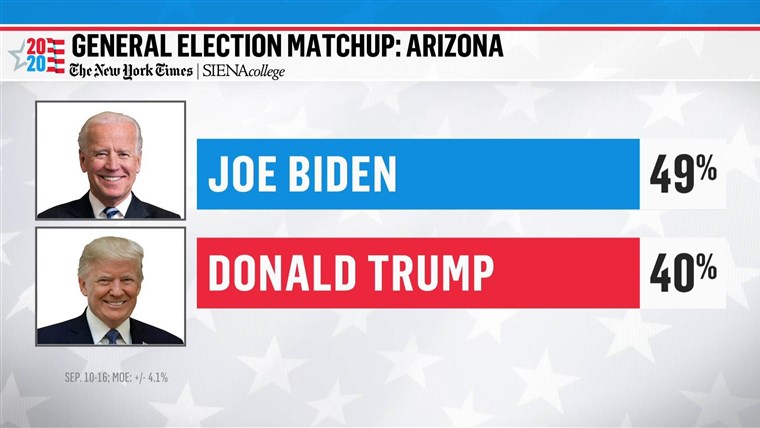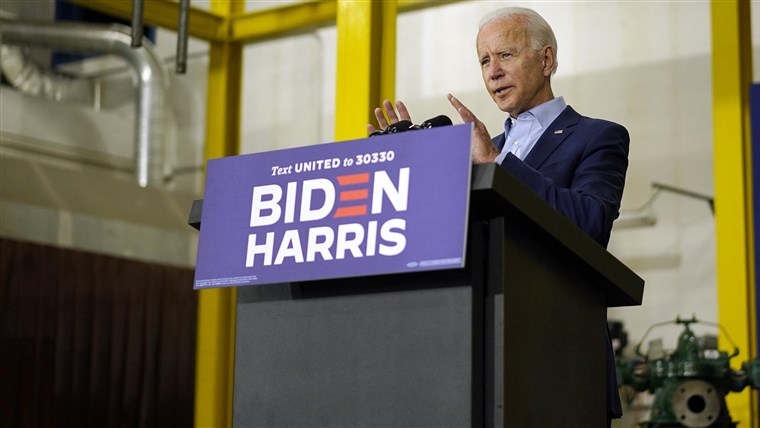WARREN, Ohio — Howard Walters, 56, acknowledges that his economic fortunes haven’t improved much since he voted for Donald Trump four years ago.
But he’s still inclined to give the president another chance.
“Trump can be a moron half of the time, but he’s so much better than what’s on the other side,” said Walters, an account manager for a small energy company in nearby Youngstown. “Trump cares about us. I know that. He’s not overly nice, but he cares about us.”
Walters said that his disappointment with the Democratic Party has lingered and that Joe Biden, the party’s presidential nominee, hasn’t offered a vision to boost Warren, the predominantly white working-class city in northeastern Ohio where he lives.
Warren was one of a number of former Democratic strongholds in the state that flipped decisively to fuel Trump’s victory in 2016, and conversations with three dozen other people in the area paint a picture of voters who still feel left behind — and are still firmly in the president’s corner, despite Trump’s having fallen short of fulfilling key economy-related promises.
Jennifer Poling, 38, a hairdresser, said that “as much as Democrats say they want to help us, Obama didn’t do anything to help us.”
“This is a blue-collar area,” she said. “Trump is trying to help us. He’s the only candidate who is going to help us.”
Poling, like Walters, voted for President Barack Obama before backing Trump in 2016, and she said she plans to vote for him again this year.
Current and former lawmakers, political strategists and other political experts said the paradox in Ohio comes down to messaging. Trump’s relentless pro-America rhetoric, ads and frequent presence have made voters here feel heard, even if the president’s policies aren’t delivering for them. On the other hand, Biden, they said, has offered myriad policies that might actually benefit the residents of the greater Warren area while increasingly sounding a populist tone, but he hasn’t effectively reached voters here. Both Walters and Poling said they hadn’t received any kind of outreach from Biden’s campaign, even as they have been getting texts, emails and calls from the Trump campaign.
Nevertheless, the state and its 18 electoral votes remain within Biden’s grasp with just 43 days to go. According to the latest RealClearPolitics polling average, Biden holds a narrow lead over Trump in Ohio, 46.7 percent to 44.3 percent. The slight advantage in a state that national Democrats feared was out of reach has Democratic lawmakers and strategists imploring Biden to work even harder to break through and mobilize people to go to the polls.
“We’ve got to talk directly to voters, to workers. Politics is all about whose side you are on, and Trump brought his phony populism to this area and betrayed them,” said Sen. Sherrod Brown, D-Ohio.
In 2018, Brown cruised to a third term, carrying the state by 7 percentage points and Trumbull County, where Warren is located, by a whopping 16 points — an eye-catching outlier that makes him the only nonjudicial Democrat elected to a statewide office.
In 2016, after Obama carried the state in two consecutive elections, Trump flipped Ohio red with the largest margin of victory for a candidate of either major party since 1988. He did so by pushing hard on a trade message that painted a picture that Democrats’ support of the North American Free Trade Agreement had allowed auto and steel factories to flee, destroying local economies.
Nowhere was this message more prevalent than in Trumbull County, where Trump promised that a struggling General Motors factory in Lordstown, just a few miles south of Warren, would stay open on his watch. Obama won Trumbull County in 2012 by 22 percentage points. Four years later, in one of the largest flips in any county in any battleground state, Trump won it by 6. He returned to the area after he won, urging people to stay and not put their homes up for sale.
The factory closed anyway, in 2019, and while the pre-coronavirus pandemic national unemployment rate shrank to a historically low 3.5 percent that year, it was nearly double that here as the region continued to struggle. Since the pandemic began, the unemployment rate has surged nationally, as well as in Ohio, including in Trumbull County.
And yet, voters here continue to say they feel abandoned not by Trump, but by Biden and the Democrats.
As the economy cratered over the summer because of the Covid-19 pandemic, Biden released a series of economic proposals under the banner of his “Build Back Better” plan, which focuses on reviving American manufacturing and was designed to counter Trump’s “America First” policies. The plan, which includes a component to address systemic racial disparities, calls for directing $400 billion in federal procurement spending to American-made products while tightening enforcement of “Buy American” provisions. It also calls for investing $300 billion more in research and development initiatives to develop new technologies that could be marketed globally.
In recent weeks, Biden has taken that message to Michigan and Pennsylvania, and he has ramped up his populist rhetoric, telling audiences in working-class areas like Scranton, Pennsylvania, and Duluth, Minnesota, that the campaign was “between Scranton and Park Avenue” and that he was proud that he would be the first president in decades not to have attended an Ivy League university.
But he hasn’t delivered that message in Ohio, a state with numerous areas where it could have an impact, lawmakers and experts pointed out.
“He’s certainly put out policies that would give a boost to the working-class economy, but I don’t think many voters, certainly not here, know much about them,” said Paul Beck, a professor emeritus of political science at Ohio State University who is an expert on the state’s political trends.
Beck said Biden would have an opportunity to speak directly to Ohio voters at the first presidential debate later this month, in Cleveland, but that he would need to come again.
Download the NBC News app for breaking news and politics
If Biden truly wants to win Ohio, added Rep. Tim Ryan, D-Ohio, he needs to “close the gap” here by pushing his own economic policies, not just criticizing Trump’s. While the president trails Biden nationally and in most swing states on a majority of key issues, the all-important question of the economy is where Americans in battleground states give Trump a persistent edge.
“He’s starting to do it. The Build Back Better, the make-it-in-America stuff — it’s excellent messaging and excellent policy. He needs to be hitting it hard,” said Ryan, whose district includes once-heavily industrial Youngstown, as well as part of Trumbull County.
Brown said he holds regular conversations with top Biden campaign brass and has urged them to visit the state, too.
“You look at Build Back Better, the make-it-in-America messaging, and he needs to keep pounding at that, and in Ohio,” Brown said.
During the Democratic primaries, Biden ended up cruising to the nomination with overwhelming support from Black voters and suburban women — valuable voter blocs that he will need in extremely high numbers in large cities like Cleveland and Columbus if he wants to win. But in many respects, Biden was positioned as a candidate uniquely suited to help the party’s performance in the general election with white working-class voters in a state like Ohio, which has larger shares of white voters and white working-class voters, who overwhelmingly flocked to Trump in 2016, than the national averages.
“He portrays himself, and accurately I think, as kind of a blue-collar guy. He comes from a blue-collar background. He’s always enjoyed strong union support, and he’s getting that in 2020,” said Beck, the Ohio State professor emeritus. “He has the right profile to appeal to voters in many parts of the state, certainly in northeastern Ohio.”
“There are all kinds of reasons why people who supported Trump in 2016 should move away from him in 2020. Part of that is that Trump is very good at sounding the same messages over and over again, even if they aren’t necessarily valid, including on the economy. That presents a real opening for Biden,” Beck said.
The Biden campaign, citing the pandemic, isn’t knocking on doors in Ohio — or anywhere else. According to his campaign, it has instead held hundreds of virtual events, sent more than 2 million text messages and made hundreds of thousands of phone calls to voters. It also pointed to the efforts of campaign allies, like Brown, who have traveled the state to talk up Biden’s economic plans.
Most critically, the campaign said, and experts noted, it has ramped up television and digital advertising in the state — particularly in the Youngstown and Toledo areas — with millions of dollars in spots that specifically push his economic policy proposals, emphasize his working-class roots and highlight his plans to combat Covid-19.
Conversely, Trump has set foot in the state multiple times in recent weeks. He gave a speech in Clyde, in the north-central part of the state, last month, and he is scheduled to visit the Toledo and Dayton areas Monday. Vice President Mike Pence visited Trumbull County and nearby Youngstown in June, and last week he traveled to Zanesville, in the eastern-central part of the state. Donald Trump Jr., one of the campaign’s most prominent surrogates, held a rally in Lima this month, as well.
The Trump campaign said it had maintained a robust presence in the state, saying that it had reached 6 million voters virtually during the time it was an all-digital operation and that it had contacted 4 million more in person since the campaign resumed normal operations.
The increased attention could be due to the fact that for Trump, Ohio is an absolute necessity to win the Electoral College, while for Biden, it could be more of a bonus.
“If Trump loses Ohio, then it’s a landslide in the general election,” said Mark Weaver, a Republican strategist in Ohio who has done campaign work for Gov. Mike DeWine and Sen. Rob Portman, both Republicans. “If Biden loses Ohio, he can still win the general election.”
That, however, would fly in the face of history.
The last Democrat to win the presidency without carrying Ohio was John F. Kennedy, in 1960. No Republican has ever won without carrying Ohio.
To continue the trend, Biden may have to come and personally convince undecided voters like Jessica Dean why he is the best choice.
Dean, who isn’t currently employed, voted for Obama and Hillary Clinton in the last three elections. But this year, she said, she’s uneasy that Biden “isn’t necessarily out to serve our best interests here” in Warren, nodding specifically to economic issues.
On other hand, “he ain’t Trump,” she said.




